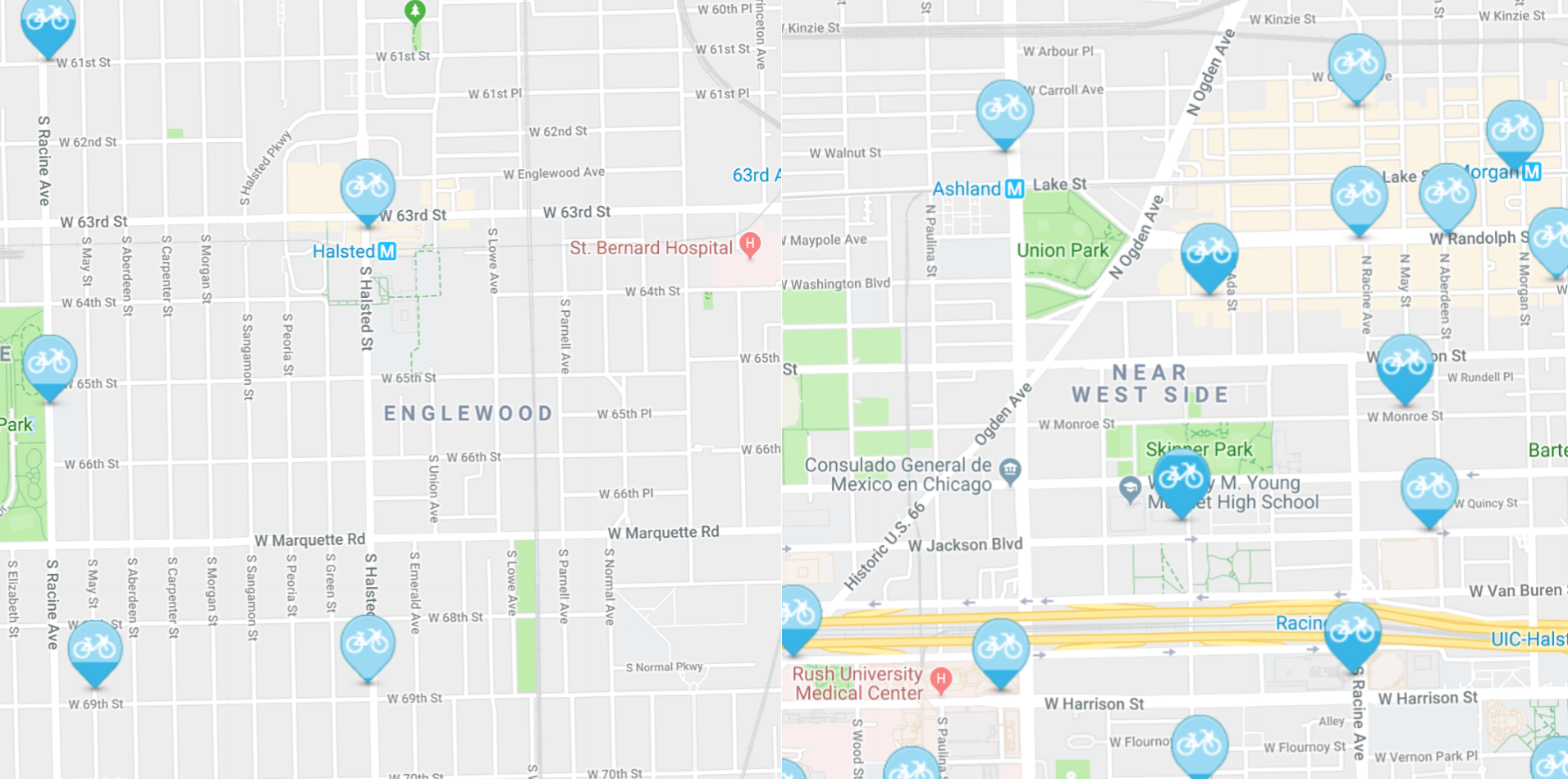In the past, there has been less Divvy ridership in Chicago's less dense, lower-income communities of color than denser, more affluent, whiter parts of town. That partly because divvy station density is generally lower on the South and West sides, with stations typically spaced a half mile apart, compared to the quarter-mile spacing that's common downtown and in many nearby and North Side neighborhoods. That means longer walks to and from stations to destinations, which makes the network less convenient to use.
The Chicago Department of Transportation, which oversees the Divvy program, seemed to acknowledge that issue at a June 2017 Mayor's Bicycle Advisory Council meeting. There deputy commissioner Luann Hamilton announced that CDOT would be adding 40 more stations and 400 more bikes to the system by the end of 2017, and would largely be using the new hardware to increase station density in communities with a dearth of Divvy docks. “Some of our newer areas don’t have quite the density that we have in other places,” Hamilton said.
She added that some of the additional hardware would be used to address the issue of bike and dock availability in high-use areas, such as downtown, which is often largely devoid of Divvy cycles after the evening rush.
However, another June has come and gone and the additional docks still haven't materialized, and CDOT never even announced the new locations. So it was a pleasant surprise this evening when the department sent word that it will be installing the new crop of stations over the next few months, starting with a station opening tomorrow at Malcolm X College, 1900 West Jackson. The new stations will "account for growing ridership, help support riders and build in flexibility in a few of the system’s busiest neighborhoods," the department stated. According to spokesman Mike Claffey, 36 stations will be added, a few less than announced last year.
But one thing that's notable about the info from CDOT is that most of the most of the communities that are getting new stations -- River North, Englewood, Ukrainian Village, and the Near West Side -- already have good station density in some or all parts of the neighborhood. Englewood is the only neighborhood mentioned that has the less-convenient half-mile station placement in all parts of the community that have docks.

And while Englewood is a low-income and heavily African-American, the other three communities are relatively affluent and have at least a plurality of white residents. For example, in the Near West Side, the most ethnically and economically diverse of the four areas, whites are the largest racial group at about 42 percent, and the median household income is $72,143, well above Chicago's median household income of $47,408.
So what explains the apparent change in strategy from focusing on increasing station density in underserved communities to adding more docks in more affluent areas that are already at least decently served by Divvy? Claffey declined to comment before tomorrow's event at Malcolm X.
It must be noted that this announcement is taking a place at a time where there has been a surge of arrests for possession of stolen Divvies -- more than 120 adult arrests since July 1, according to the crime blog CWB Chicago. (Divvy has acknowledged the theft problem and says they're retrofitting their docks with more secure locking technology.) Most of the arrests have occurred on the south and South and West sides, according to CWB's map of the arrest sites.
On the other hand, there have also have been plenty of Divvy arrests downtown, including River North. Recently Black bike advocate Eboni Senai Hawkins witnessed police pulling over a young African-American man on a Divvy for riding on the sidewalk at Chicago and Rush. The officers immediately handcuffed and searched him, and then traced the number on the bike, determined it was stolen, and jailed the man.

Senai Hawkins argued that the officers' decision to stop the man in the first place was a case of racial profiling, since many people of all races ride Divvies on downtown sidewalks, but police stops, let alone arrests, seem to be rare. That accusation is made more credible by the fact that earlier this summer a CPD rep acknowledged that the force has been using zero-tolerance bike enforcement in some Black and Latino neighborhoods as a pretext to conduct searches, while most majority-white neighborhoods see few bike tickets. Last Thursday I met another young Black man who was stopped on a Divvy in the same location, and was also cuffed, searched, had his bike number traced, and was jailed for possession of a stolen bike.
Update 8/29/18: In the wake of a CWB Chicago post critiquing our coverage of the Divvy enforcement issue, we've been getting an influx of trolling comments from fans of the anonymous crime blog. To simplifying comment moderation, I've closed the comment sections for our earlier articles on the subject (CWB doesn't have comment sections.) Feel free to weigh in on our article responding to the CWB post, but please do so in a reasonably civil manner.






